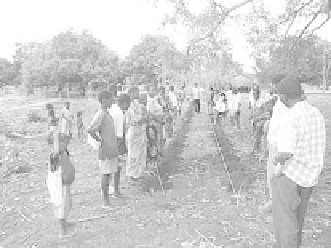Environmental Engineering Reference
In-Depth Information
involvement of stakeholders (all those with an interest in the resource, not just
'experts') in developing this plan is the first stage in management success. In
Chapter 7 we consider implementation in depth, with a particular emphasis on
how to guide decision-making when there is uncertainty, and how to monitor the
system and feed back the findings from monitoring into ongoing adaptive
management.
Box 6.10
Community Markets for Conservation (COMACO).
Early experiments in integrating conservation and development have been widely
criticised. However, experience has much improved the approach and now com-
munity-based natural resource management, one manifestation of this integrated
way of thinking, is widespread. CBNRM has been taken up by governments
around the world, particularly in southern Africa (see Resources section for
websites). One particularly successful project is COMACO, which is based in the
Luangwa Valley in Zambia and was initiated by the Wildlife Conservation Society.
Although it has only been in existence since 2003, it is built on several decades of
conservation experience in the area. It's also unusual in the clarity with which it
states its underlying principles in the form of testable hypotheses.
COMACO's heart is a cooperative trading association for agricultural produce
that guarantees fair prices at regional trading depots. However, its activities
include tourism, wildlife law enforcement, forest management, capacity-building,
promotion of sustainable farming methods and help for health professionals
(Figure 6.13a). They also promote alternative livelihoods such as bee-keeping,
poultry and fish ponds, particularly targeting ex-poachers (Fig. 6.13b). They
process produce themselves to increase value-added, and to give a brand identity.
This programme combines many of the strategies discussed in this chapter,
including alternative livelihoods, generation of community goodwill and direct
(a)
(b)
Fig. 6.13
a) A course in conservation farming for COMACO members; b) a
bee-keeper. Photos © COMACO.



